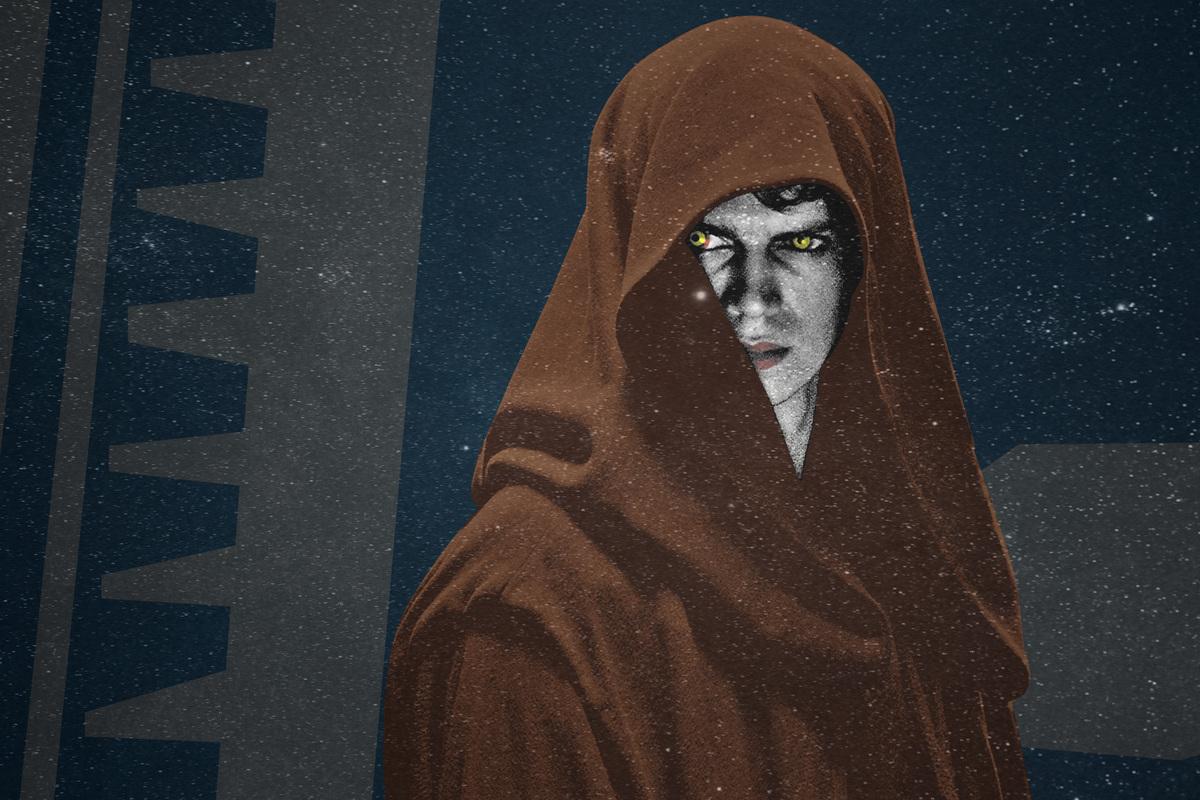
If the strength of a franchise’s legacy were defined by the number of memes it spawned, the Star Wars prequel trilogy would be among the most heralded works in the history of cinema. Far from having a limited shelf life, prequel memes have continued to thrive since the trilogy’s release in the early 2000s—even evolving to make their way onto emerging platforms like TikTok. (Prequel memes are ubiquitous enough that I began my pitch for this essay with “hello there.”) While it would be a touch unfair to make a blanket statement for the intent behind meme-ing The Phantom Menace, Attack of the Clones, and Revenge of the Sith to death, many of the executions don’t seem mean-spirited, despite often highlighting the trilogy’s wooden dialogue, overabundance of CGI, offensive caricatures, and terrible acting. It’s more like we’ve all come together to laugh and confess that we love trash at the altar of our lord and savior, George Lucas.
Like the rest of Star Wars on the big screen, I have watched the prequels more times than I can count. I remember every detail of the ‘50s-style American diner that somehow exists on Coruscant. I know every reason why Anakin Skywalker doesn’t like sand. I have tried my best to understand the logic behind the first opening crawl of a new trilogy describing the taxation of trade routes (kids love their Space Tax). I unironically believe podracing is cool—maybe even the part in outer space when young Anakin says “now this is podracing!” when he is not, in fact, podracing. Navigating the space between adoring something undeniably flawed and providing a critical retrospective for the material is like trying to slip a torpedo through the Death Star’s tiny exhaust port.
But not all prequel derision should be created equal. While the three films are typically grouped together as low points for the franchise, I contend that Revenge of the Sith shouldn’t be treated with such indignation. (The movies’ respective Metacritic scores at least confirm that Revenge of the Sith is the best reviewed of the trilogy, as it should be.) By 2005, Lucas hadn’t totally worked out some of the prequel’s kinks—namely, an inability to write dialogue that doesn’t, at its very worst, feel like Elon Musk trying his hand at a screenplay—but Revenge of the Sith was too tantalizing to completely fail because of what the trilogy-ender represented.
For all the bizarre directions of the earlier entries, with dry Trade Federation detours and a wasted Christopher Lee performance as the pointless villain Count Dooku, Revenge of the Sith was destined to fill in one of the most exciting gaps of the Star Wars mythos: Anakin’s inevitable transformation into Darth Vader. However clumsily it was set up, Anakin had to betray the Jedi Order and something had to happen with Padmé, but not until Luke and Leia were born and separated. And, of course, Chancellor Palpatine would have to finally reveal himself to be a Sith Lord—a moment that hopefully didn’t register as shocking for anyone since the prequels basically made it an open secret to everyone but the Jedi.
Defending some of the ways in which Lucas scripted these reveals is a losing battle, but there are genuinely devastating and engrossing sequences in the path toward Vader: the anguish when Anakin concludes that he must embrace the Dark Side to save Padmé from death; when he activates his lightsaber in a room full of young Padawans after pledging himself to Palpatine; the consequences of Order 66; when he confronts and Force-chokes Padmé, fulfilling the thing Anakin feared most; the venomous rage in Anakin-cum-Vader’s eyes after Obi-Wan Kenobi slices him in half from (I know) the high ground and before his body is slowly incinerated.
As cringe-worthy as Hayden Christensen’s acting could be—in his defense, the scripts rarely did him any favors—it did end up serving what appeared to be Lucas’s motivation. Rather than build upon the myth of an epic villain like Darth Vader, the prequels tore him down. With all of his impulsive, petulant, and self-destructive behavior, Anakin didn’t make villainy look cool; he made it seem pathetic. (In retrospect, Anakin and the try-hard Kylo Ren had a lot in common.) We all make fun of Anakin first donning the iconic Darth Vader helmet and shouting “NOOOOOOOO!” for the sheer ridicule such a moment provides. Maybe the theatrics were the point.
That philosophy would certainly align with Revenge of the Sith’s undisputed MVP: Palpatine himself. After spending two films hiding behind the facade of a genial politician, Ian McDiarmid got to fully lean into camp at the end of the trilogy. With Palpatine taking only a few minutes of screentime before explicitly revealing some of his monstrous intent—first by ordering Anakin to execute Count Dooku—McDiarmid relishes in peeling the layers back on a manipulative, comically evil presence. The performance both allows us to understand why someone like Anakin would fall for Palpatine’s slimy charm as well as expose the Jedi Council’s fatal hubris when their biggest enemy was right in their face the whole time. (The Jedi’s failures are also interrogated in The Last Jedi, yet that film’s detractors act like Rian Johnson betrayed Lucas’s vision.) By the time Palpatine finishes frying poor Mace Windu—a ridiculous sequence that gives us three Hall of Fame quotes: “I am the senate,” “It’s treason, then,” and “UNLIMITED POWER!!!!”—it’s clear McDiarmid is in on the bit. I’m only half-kidding when I say he deserved an Oscar nomination.
Where Revenge of the Sith still feels weighed down is in its strenuous commitment to doing the absolute Most. Aside from setting up Anakin’s transformation into Darth Vader and unleashing Palpatine’s master plan, the film juggles two other secondary villains in Count Dooku and General Grievous. The grimly funny solution to the Dooku dilemma—how do we tie up this unnecessary loose end from Attack of the Clones?—was simply having him lose a lightsaber battle on a spaceship within the first 15 minutes of the movie, an unceremonious end for a character who was a transparent Palpatine placeholder. (Christopher Lee deserved better!)
The introduction of Grievous, meanwhile, was perhaps burdened by the lofty expectations of certain viewers (like myself) who watched Genndy Tartakovsky’s now-decanonized Clone Wars series, where the droid general was more akin to an unstoppable Jedi Terminator than the coughing mess he turned out to be. Grievous was conceptually—and maybe incidentally?—a kind of Vader prototype; a weird cyborg thing that never meshed with his new body, as evidenced by a phlegmy cough. (In Clone Wars, the cough was shown to be a result of Mace Windu using the Force to crush part of Grievous’s torso, which was way cooler.) The presence of General Grievous also gave Lucas an easy excuse to split up Anakin and Obi-Wan so that the former could be turned to the Dark Side without his mentor over his shoulder—and while Grievous’s showdown with Obi-Wan was itself a meme gold mine, it did add to the overstuffed nature of this trilogy-ender.
In that respect, however, Revenge of the Sith is representative of a moment when big franchises concluded trilogies by trying to do as much as possible and bring as many new adversaries to the fore. Spider-Man 3 had Peter Parker juggling Harry Osborn, Sandman, and an unfortunate interpretation of Venom-as–Eric Foreman; X-Men: The Last Stand mixed in a Dark Phoenix story with Magneto, the Juggernaut (bitch), and countless other Mutants; Pirates of the Caribbean: At World’s End introduced viewers to Singapore and surreal pirate purgatory. Some of these overstuffed trilogy-enders fared better than others with critics and audiences—I will always walk the plank for Gore Verbinski’s Pirates films—arriving right before the first phase of the carefully calibrated, somewhat formulaic Marvel Cinematic Universe. (It’s a little miraculous that the MCU has found a way to juggle dozens of stars in Avengers entries without the whole thing falling apart.)
But even when it leans into Lucas’s worst impulses, Revenge of the Sith works on several fronts. Fifteen years on, the film remains a compelling, operatic tragedy featuring some of the darkest moments of the entire franchise; somewhat paradoxically, it is also exceptionally entertaining for some absurdly stilted one-liners I can’t stop thinking about. (I like the part when Anakin says, “This is where the fun begins,” before some of the fun begins.) Whether you’re watching for the moments of actual pathos or just waiting to shout lines like “YOU WERE THE CHOSEN ONE!” in unison with friends, Revenge of the Sith holds up.
And despite the prequel’s glaring flaws, at least Lucas got to spend more time in the world he created before the Empire (Disney) took the reins of the franchise. Off the heels of a third trilogy to bookend the so-called Skywalker Saga—a mess of competing visions, franchise retconning, and a general lack of purpose exposed by a company’s desire to please everyone—there is something wistful about the product of one dude executing his bonkers vision for an enterprise worth billions of dollars.
The prequels didn’t always strike the right balance in the Force—The Phantom Menace is stealthily better than its reputation; Attack of the Clones should be hurled into the sun—and the trilogy has more than its share of detractors. But for what might end up being Lucas’s final feature film as a director, Revenge of the Sith deserves a lasting legacy beyond all the dank memes. It’s good, and for all its issues, the movie almost approaches greatness. All told, Revenge of the Sith will always be a fine addition to the Star Wars collection.

